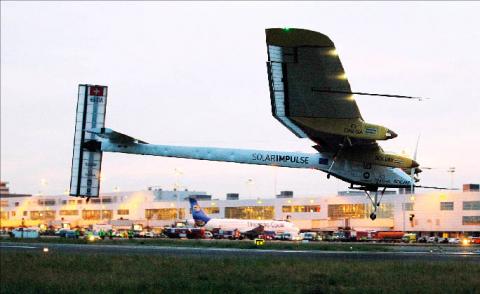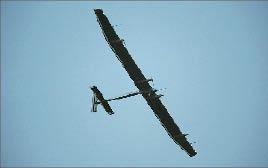Pioneering Swiss solar-powered aircraft Solar Impulse landed in Brussels on Friday after completing its first international flight, 13 hours after it took off from Switzerland.
“I captured more energy than I used,” said pilot Andre Borschberg as he descended from the plane amid the applause of hundreds of people including Belgium’s Crown Prince Philippe, who had followed Solar Impulse’s long descent from a helicopter.
“I flew with the power of a scooter,” Borschberg added.

Photo: Reuters
“This is wonderful,” said Bertrand Piccard, joint founder and president of the Solar Impulse project.
The single-seater had lifted off gently in clear blue skies from Payerne airbase at 8:40am after being delayed by early morning mist.
It covered the roughly 480km from western Switzerland to Brussels airport, flying over France and Luxembourg at 3,600m.

Photo: AFP
“With this flight, we would like to encourage politicians to opt for more ambitious energy policies,” Piccard said before the aircraft landed.
He also called for “a change in mentalities to encourage people to use new [green] technologies” and stop wasting fossil energies.
“It is crazy that mankind wastes a billion tonnes of oil an hour,” he added. “Who wants to believe that we will keep planes that burn up so much fuel?”
“The flight is going really well, I have just flown over Liege, it’s a real pleasure to enter Belgian airspace,” Borschberg said as the dragonfly-like experimental and emissions-free aircraft cruised at 50kph.
“The view I have here is extraordinary,” the Swiss pilot added in a live feed over the Internet. “I’m above the clouds, for now I’m taking advantage of the blue sky.”
Solar Impulse HB-SIA, which has the wingspan of a large airliner, but weighs no more than a sedan, made history in July last year as the first manned plane to fly around the clock and through the night on the sun’s energy.
It holds the endurance and altitude records for a manned solar-powered airplane after staying aloft for 26 hours, 10 minutes and 19 seconds above -Switzerland, flying at 9,235m.
The high-tech plane has since flown several times, notably between Geneva and Zurich airports, but the journey to a busy airport in Brussels through crowded airspace was regarded as a new test.
“Flying an aircraft like Solar Impulse through European airspace to land at an international airport is an incredible challenge for all of us, and success depends on the support we receive from all the authorities concerned,” said Borschberg, who also piloted July’s flight.
The HB-SIA relies on 12,000 solar cells on its 64m wings to charge the batteries that provide the energy for the 10-horsepower electric motors driving four propellers. Its record-breaking flight last year demonstrated its capacity to store up enough energy to fly through a summer night.
The showcase for green technology will be on display at Brussels airport until May 29 before flying to the international air show at Le Bourget in Paris from June 20 to June 26.
“This time, we have a real airplane — flying —- proof that new technologies can reduce our dependence on fossil energy,” Piccard said.
The Solar Impulse team is planning to fly even further, including possible transamerican, transatlantic and round-the-world flights — in stages — in 2013 and 2014 using a slightly larger aircraft.
Asked about upping the speed, Borschberg said: “That’s not the aim of this plane for now.”
Piccard, himself the first man along with Briton Brian Jones to fly non-stop around the world in a balloon, comes from a dynasty of pioneers.
His grandfather Auguste Piccard twice beat the record for reaching the highest altitude in a balloon, in 1931 to 1932.
His late father Jacques Piccard was a deep sea explorer who holds the record for traveling to the deepest point underwater, 10,916m below sea level in the Marianas Trench in the Pacific.

TAKING STOCK: A Taiwanese cookware firm in Vietnam urged customers to assess inventory or place orders early so shipments can reach the US while tariffs are paused Taiwanese businesses in Vietnam are exploring alternatives after the White House imposed a 46 percent import duty on Vietnamese goods, following US President Donald Trump’s announcement of “reciprocal” tariffs on the US’ trading partners. Lo Shih-liang (羅世良), chairman of Brico Industry Co (裕茂工業), a Taiwanese company that manufactures cast iron cookware and stove components in Vietnam, said that more than 40 percent of his business was tied to the US market, describing the constant US policy shifts as an emotional roller coaster. “I work during the day and stay up all night watching the news. I’ve been following US news until 3am

UNCERTAINTY: Innolux activated a stringent supply chain management mechanism, as it did during the COVID-19 pandemic, to ensure optimal inventory levels for customers Flat-panel display makers AUO Corp (友達) and Innolux Corp (群創) yesterday said that about 12 to 20 percent of their display business is at risk of potential US tariffs and that they would relocate production or shipment destinations to mitigate the levies’ effects. US tariffs would have a direct impact of US$200 million on AUO’s revenue, company chairman Paul Peng (彭雙浪) told reporters on the sidelines of the Touch Taiwan trade show in Taipei yesterday. That would make up about 12 percent of the company’s overall revenue. To cope with the tariff uncertainty, AUO plans to allocate its production to manufacturing facilities in

COLLABORATION: Given Taiwan’s key position in global supply chains, the US firm is discussing strategies with local partners and clients to deal with global uncertainties Advanced Micro Devices Inc (AMD) yesterday said it is meeting with local ecosystem partners, including Taiwan Semiconductor Manufacturing Co (TSMC, 台積電), to discuss strategies, including long-term manufacturing, to navigate uncertainties such as US tariffs, as Taiwan occupies an important position in global supply chains. AMD chief executive officer Lisa Su (蘇姿丰) told reporters that Taiwan is an important part of the chip designer’s ecosystem and she is discussing with partners and customers in Taiwan to forge strong collaborations on different areas during this critical period. AMD has just become the first artificial-intelligence (AI) server chip customer of TSMC to utilize its advanced

Six years ago, LVMH’s billionaire CEO Bernard Arnault and US President Donald Trump cut the blue ribbon on a factory in rural Texas that would make designer handbags for Louis Vuitton, one of the world’s best-known luxury brands. However, since the high-profile opening, the factory has faced a host of problems limiting production, 11 former Louis Vuitton employees said. The site has consistently ranked among the worst-performing for Louis Vuitton globally, “significantly” underperforming other facilities, said three former Louis Vuitton workers and a senior industry source, who cited internal rankings shared with staff. The plant’s problems — which have not